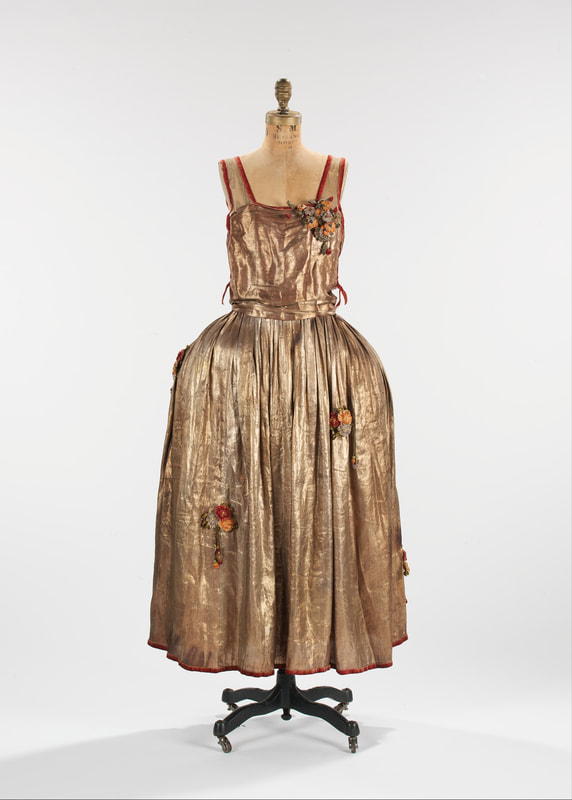Meanwhile, she is loved by an English soldier. Things get tragic. Honestly, I didn't find it all that interesting, despite it having such dramatic elements. Despite all the politics, love triangles, and bloodshed, the part I remember best was the rather odd garment worn by the young lady to a ball... a flat-chested boxy bodice with large skirt poofing out from the hips. I thought it was very unflattering. In the 1920's, when the slim boxy silhouette we now think of as a flapper dress was in vogue, older women or younger girls would opt for a more conservative gown, with more feminine lines and a bit of foofaraw on the hips. Called the "robe de style" (say "ROBE duh STEEL"), this garment required some 18th century style underwear, which was often built into the dress, for fullness on the hips. The big skirt below the sleeveless, low-waisted top looks very odd to modern eyes, but at the time, it was seen as the less daring option, the safe route for women who lacked either the flapper figure or the flapper sensibilities. It may have been the safe route in its day, but it is little known nowadays. Even YouTube, usually a trove of historical costuming videos, only yielded one video about a robe de style. I admit, the first few times I saw a robe de style I thought it was second only to the English Regency court gowns in hideousness. The proportions... so wrong! But some tastes develop from repeat exposure, even when the first impression is bad. I blame Simplicity 3631, which introduced me to the easy comfort and attractions of a low-waisted dress. First I made the Bonsai Dress, then the Sunshine Dress. They are so easy to wear, yet not sloppy, and the movement in the fuller skirt of the Sunshine Dress is fun. Yet these garments are still firmly in normal-clothing territory. The robe de style, with its side hoops (panniers) to enlarge the hips, is well into costume territory. I wouldn't wear one to work, for instance. UPCOMING BALL But I do have a ball coming up (Portland loves themed balls!), for which a good dancing costume is required. Historical clothing or fancy dress are encouraged, but I don't want anything heavy or corseted, since I intend to dance all night! And I don't have much time to make myself a costume, as I'll be making a ball gown for a friend and kluging a ball gown together from several dresses for another friend. Lots of ball gowns on the horizon! So the robe de style looks more and more appealing. I could use Simplicity 3631 as a base, and the only really tricky bit will be the panniers to hold the skirt out. It's the panniers that take me Out of My Comfort Zone. (on the other hand, I could put pockets in the panniers, which will be convenient! Accurate for the colonial era, but I'm not sure if they're accurate for the 1920's.) I BEGIN TO RESEARCH... And by "research" I mean "look at pretty pictures" and "read historical sewing blogs". Okay, so I won't be winning any awards for academic rigor! But it's a quick fun project, all right? (Don't look at me like that! I can do quick! I can make something without overmaking it! I can-- Oh, shut-up.) Starting with my Pinterest page, I make the following observations:
FABRIC IDEAS Since I'm trying to whip something up quickly, I want to work from stash. I figure that a stiffer fabric will hold the poofy skirt out more easily as well as disguising somewhat the skeletal lines of the panniers. So the white polyester satin I have from a wedding dress might be a good base. But I don't want a white dress, so maybe I can over-lay it with some marvelous ombre-dyed silk sari fabric I have (yay thrift stores!). Then it would be a beaded green and gold dress. Autumn 2017 Sewing List
(And yes, I know I promised an update on the Ahsoka Tano project diary... it's written, but not integrated with its photographs yet. I'm running late, but real life priorities eclipsed computer time this week. It'll come soon!)
2 Comments
Kate
10/22/2020 06:46:03 am
Have you seen this vlog? She featured a Robes de Style dress and I thought you might like
Reply
Hi Kate! Thanks for the link.
Reply
Leave a Reply. |
Karen Roy
Quilting, dressmaking, and history plied with the needle... Sites I EnjoyThe Quilt Index Categories
All
Archives
March 2024
|

 RSS Feed
RSS Feed